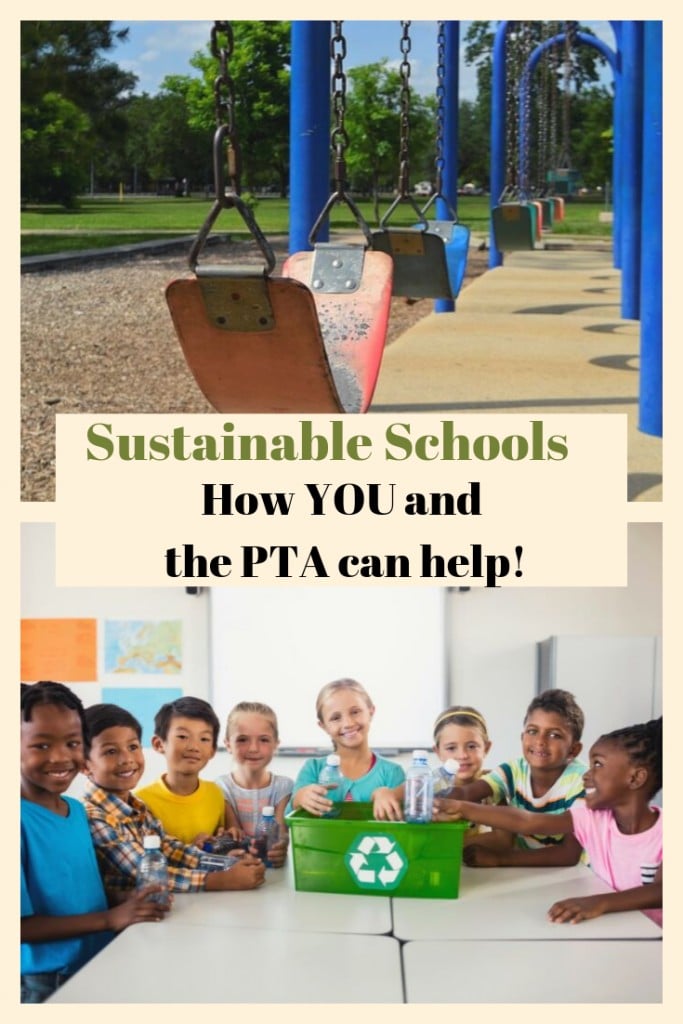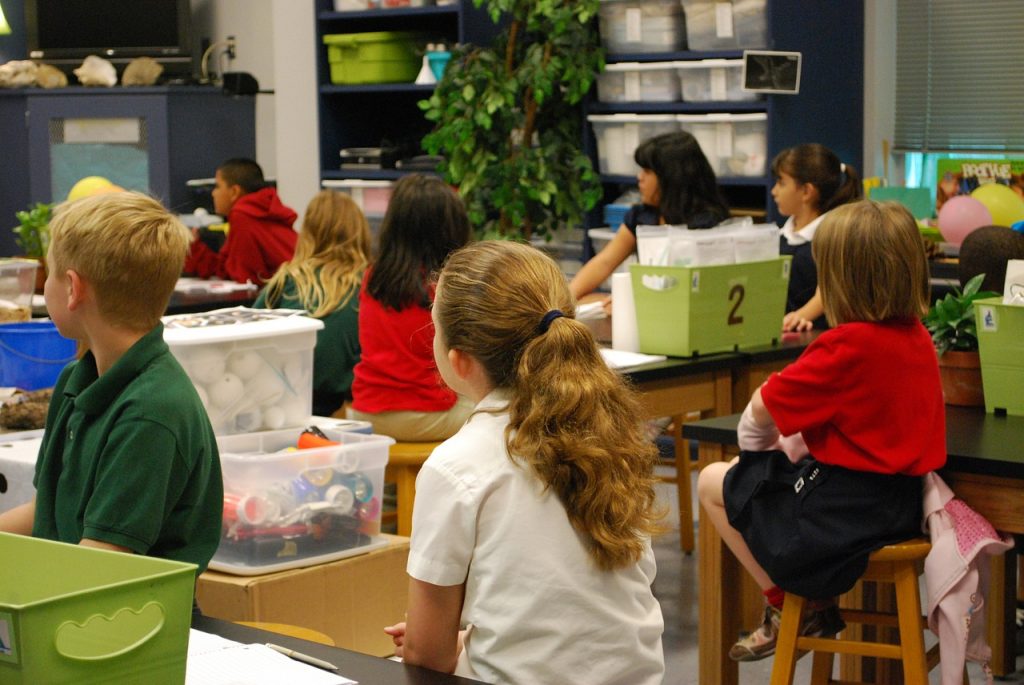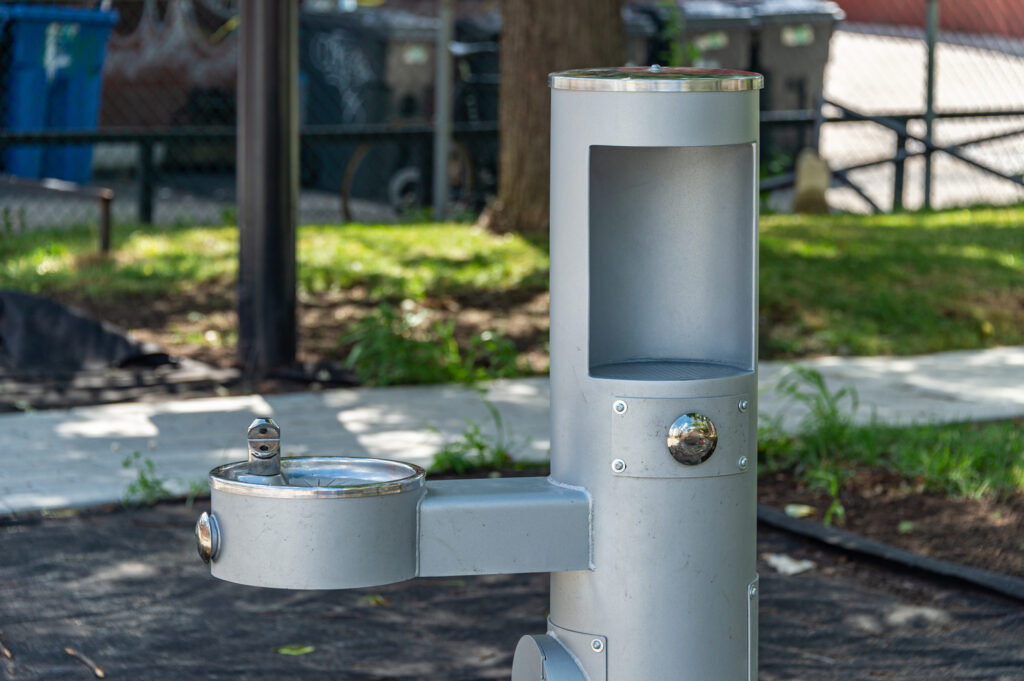Have you ever wished for more environmentally friendly schools in your area? Did you ever think that maybe YOU could help play a part in implementing a few eco-friendly school ideas in your town?
I am going to share a few simple but sustainable ideas for you to research and implement this fall. There are many, MANY, ways to green your school but most of them require that parents, kids, and teachers get involved.
Whether you choose to talk to the cafeteria about food waste or the groundskeeper about sustainable school ground management, the first step is to understand how your school is run and organized. Only then can you tackle the challenge of instituting these environmental ideas for schools.
From getting kids to help plant a school garden to hosting a book sale with the local community, by getting others involved, you will make your life a lot easier. There are MANY green practices that a school can adopt and hopefully, this post will help you get started.
Posts feature partner companies & may be sponsored. Post contains affiliate links & I will be compensated if you make a purchase after clicking on links. As an Amazon Associate I earn from qualifying purchases.

Table of Contents
Why Push for Sustainable Schools?
Why do we need green schools? Most of the time, parents are expected to be the ‘teachers’ when it comes to their children. We teach them to walk, talk, use the potty, do their math homework (at least until 6th grade!) and drive a car. We hope (or pray!) that our lessons are well accepted and our children become well-adjusted members of society.
What if teaching eco-friendly lessons went from child to parent and not the other way around? When your kids head back to school in the fall, talk to teachers and administrators about these important environmental ideas for schools.

✯Don’t want to miss the next post?✯
Follow Turning the Clock Back on Facebook | Twitter | Pinterest
Or join the private Facebook group for simple tips on going green!
Green Classrooms Mean Smaller Footprints
There are certain things that we, as parents, can learn from our children. The environmental movement needs to capitalize on this idea for increased awareness. Adults are often stuck in their ways. They are determined to do the same things over and over just because it is how they have always done them.
Like these eco-friendly school ideas? Try these posts, too!
- Celebrate America Recycles Day with These Green Activities!
- Green Mom Guilt and Parenting Priorities
- Easy Green Living Tips for College Students
- The 6 rs of sustainability: It’s more than just recycling.
Are you idling the car while waiting in the carpool line? Throwing out your soda can instead of recycling it. Throwing a cigarette butt out the window instead of putting it in your ashtray (or quitting all together!). Sound familiar?
These are all habits adults have already formed but with a little bit of guilt from our children, we may just think twice about our choices. The eco-friendly school ideas that our children are exposed to in the classroom don’t just stop once they walk out the door.

Kids Bring Green Lessons Home
Kids spend 8 hours out of just about every day at school. In order for environmental activists to change the way that people impact the world around them, they need to start with the little people FIRST. Teach kids about reducing, reusing, and recycling. Then, they will bring those lessons home and teach their parents.
The next time mom goes to toss a can in the trash, little Susie may just speak up. “Mom, you know you really should recycle that!”. And maybe, (just maybe!) mom will listen! Eco-friendly school ideas not only teach lessons to our children but in turn, those lessons go home to parents as well. Eco-friendly children are vital to the survival of this planet.

Today’s Kids are Tomorrow’s Adults
According to Wikipedia, in 2000, there were 76.6 million students enrolled in schools. Kids enter school at around 5 or 6 years of age. They graduate high school at about 18. That is over 13 years that we could be teaching them how to care for our environment!
Want to get your school to go green but you aren’t sure how to do it? I was the chair of my kid’s Environmental Committee for 4 years and learned quite a few things along the way. Is it easy? NO. Sometimes it can be downright frustrating but it does have its rewards.

Questions to ask your school administrators
As I mentioned above, before you decide what changes you want to see, you need to understand the scope of the problem you are dealing with. And remember that some changes may be possible, and others may not.
Part of the problem you will encounter is that not all changes can be made at a school level. Districts, counties, and states play a large role in decision-making for individual schools. But, here are a few key areas to look into when fighting for sustainable schools.
1. How often are the recycling bins emptied?
Or do they not have bins for paper recycling at all? Young people of all ages are capable of putting scrap paper in recycling bins. Along the same lines, does the school buy recycled paper?
2. What type of light bulbs are used in classrooms and common areas?
LED bulbs are an easy and energy efficient change for schools to make. While a school-wide change all at once might be challenging, swapping out one or two light bulbs at a time will reduce energy use and is one of the easiest ways to make a difference in how green your school is.
3. Are there any energy-efficient appliances or devices in use?
At home, energy efficient appliances are fairly common nowadays. Ask your school administrators whether the copiers and printers are green school approved!
4. Is there a school garden or other green space on campus?
A school garden is a great way to get kids involved with your sustainable school initiative. Lessons that go along with school gardens include everything from the benefits of local food to soil health and erosion.
5. Is composting a possibility at your school?
Ask your cafeteria staff if it is possible to divert food waste from the cafeteria to a compost bin to help fertilize your school’s outdoor garden. Food waste is a growing concern throughout the entire planet and diverting it into compost is a great way to reduce the school’s carbon footprint. Hang a list of noncompostable items where it will be seen to keep your compost healthy.
6. Are there water bottle filling stations available?
Single use plastic is contributing to global warming, destroying our oceans, and unnecessarily filling up our landfills. Many schools are reducing plastic pollution by installing water bottle filling stations. Young people today are much more likely to bring a reusable water bottle to school than kids were decades ago.
7. What type of cleaning products are used throughout the school?
From wiping down cafeteria tables to school-wide floor mopping, there is a lot of cleaning that goes on in schools. Look for ways to make it more sustainable. Spray bottles and reusable rags can replace disposable wipes. Green cleaning products in replace of harsher chemicals may also be a sustainable choice for cleaning.
8. How does the school communicate with parents about environmentally friendly initiatives?
Communication is key when implementing your changes. Include a blurb in your school newsletter asking parents to reduce how much single use plastic and paper they send in. It’s the perfect opportunity to spread green awareness throughout your local community.
9. How does the school transportation system impact the environment?
Take a look at your school bus procedures and the length of your school’s carpool line. Start encouraging a ‘no idling’ campaign to improve air quality on school grounds. Look into air quality meters to really understand the scope of the problem. Encourage walking to school for students who live close by.
10. Are there any environmentally friendly construction or renovation projects planned?
School buildings need updating regularly. Whether it’s the installation of solar panels or updating the school’s water system, when your school needs updating, encourage leaders to keep sustainability in mind.

How to Spread Your Eco-Friendly School Ideas
When a child recycles their scrap paper or takes one less paper towel in the bathroom I cheer inside just a little bit. Here are a few environmentally friendly school ideas that might help you change a few kids’ behaviors at your local school.
Start an Environmental Committee
One person cannot do it all alone. I know, I tried! Talk to your school’s PTA president. Bring up the idea of starting a committee to help the school go green. Gather like-minded parents to help you. How do you find them? Go to lunch with your child. The kid eating organic granola bars and using cloth napkins has an eco-friendly mom, I guarantee it!
Once you have a committee established, make a list of programs to implement. From used book drives to a reusable water bottle campaign, get the kids involved as much as possible.
Talk to the school staff
Schools purchase a LOT of stuff! Toner cartridges, copy paper, pencils, etc are all available in both green and NON-green options. See what the school’s policy is on purchasing these items and if they are willing to switch. You can donate a few eco-friendly school supplies to your child’s teacher. However, you can’t fund the whole school out of your own pocket.
You may also want to discuss the types of cleaners that the custodial staff uses and how they are disposed of. They will have contact information for the school’s district if you want to speak with someone higher about possible changes. Look into a paper recycling facility in your area and see if you can get the school to start recycling some of the paper waste they create!
Make a visit to the classroom
It is hard to actually teach kids about the environment without involving the teachers themselves. Check out this list of environmental lesson plans and see if they are willing to incorporate the discussions into their own classroom.
While most schools must ‘teach to the test’ and make sure the students are taught certain academic skills, it is very easy to include environmental lessons at the same time. Focus on topics like Earth Day or Earth Hour. Ask your child’s teacher if you can read an Earth Day book at story time to the class.
If they are teaching math, they could include a discussion of parking lot surface area and rain runoff. Maybe in language arts, they could work on correcting the punctuation of a story that focuses on river cleanup. The options are endless! Check out my environment worksheets on Etsy for a few printables that might help.
Start an environmental club
The committee mentioned in number one above is for adults. An environmental CLUB is for the kids! Maybe an after-school meeting once a week would be a great way to get dedicated kids to make a difference in their community.
What sort of things could they do? Paint a rain barrel, make posters for the school hallways, help with a recycling drive, go out on a river cleanup in their town, and plant a garden on the school property that they could learn to maintain. These are minds that are just waiting to absorb lessons about caring for the world around them.

Look into green fundraising
Many of the activities you may want will require a small amount of money. Ask for donations from parents and raise money with an eco-friendly sale of some sort. Have a second-hand book sale or sell sustainable items from companies like Equal Exchange or Smencils (kids LOVE smelly pencils!).
Contact your local nursery and see if they are willing to donate seed packets. Any donation that can be sold for a small fee will bring money into your school’s pocket.
Tackle the school lunch program
This is a tough one and not a battle that will be easy. Most public school lunches are as far from nutritious and ‘green’ as humanly possible. You won’t find a lot of healthy lunches in the cafeteria line.
If your school uses disposable trays or serves food that is ‘ready to heat’ and not cooked in house you have your work cut out for you. Check out Two Angry Moms for a deeper look at the school lunch program and what you can do to change it.
Check out this preview of Two Angry Moms for more info on their mission.
Funding for Green School Initiatives
Research grants from the federal government or private sources to help fund your green school initiative. Check out the Department of Education website for more information on how to start funding. They have links to many programs that are free and just waiting to be brought into your child’s school.
If just ONE green-minded parent helped enact a few changes in their child’s education, that same environmental lesson may also be absorbed by hundreds of other kids in that same school. And if those 100’s of other kids go home and lay just a little bit of a guilt trip on their parents for idling in the parking lot, you have taken a huge step towards improving our environment.
The eco friendly school ideas that you implement in the classroom may very well make it back home without any additional effort on your part.

Diane is a professional blogger and nationally certified pharmacy technician at Good Pill Pharmacy. She earned her BS in Microbiology at the University of New Hampshire and has worked in cancer research, academics, and biotechnology. Concern over the growing incidence of human disease and the birth of her children led her to begin living a more natural life. She quickly realized that the information she was learning along the way could be beneficial to many others and started blogging and freelance writing to share this knowledge with others. Learn more about her HERE.

What an inspiring post! I’ve been thinking about this issue for awhile but don’t really know where to start. The school lunch issue is huge for me. I send lunches with my kids. I would really like to start a veggie garden where the kids can learn how to grow food. I really like your idea about an environmental club. I need to act.
Thanks so much for the support and ideas! I love the idea of a veggie garden and selling them to raise money! The area of the country I live in isn’t known for it’s Green Initiatives but I keep hoping the message is getting across anyhow!
I work for a non-profit environmental group and right now I can tell you that you’re right. There is a big push with federal grant money being passed onto schools under the Safe Routes to School Program.
I passed your blog post onto my co-worker who handles our program here in South Jersey.
Yay for green!